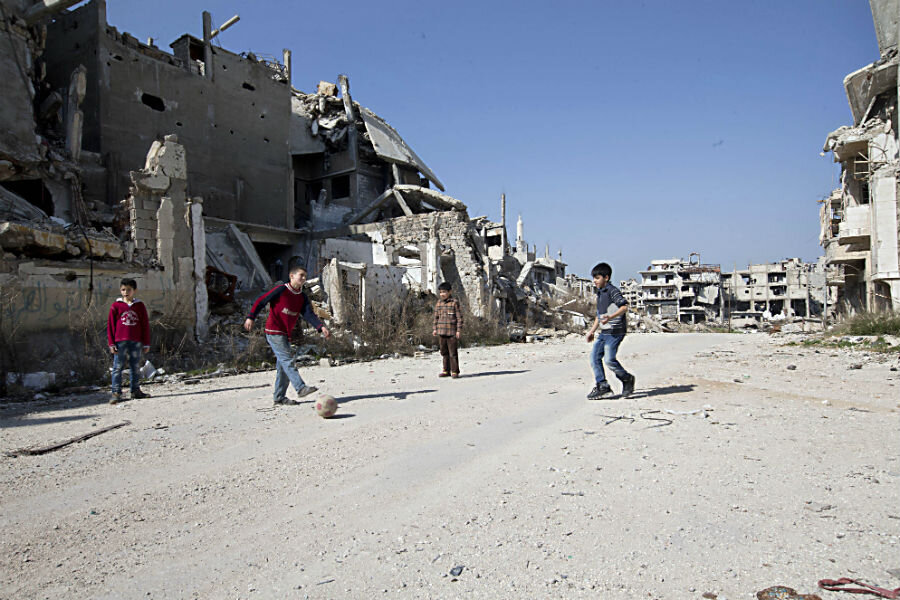Syria cease-fire: What happened on Day One
Loading...
| Beirut
A US and Russian-brokered cease-fire brought relative calm to parts of Syria for the first time in years on Saturday despite numerous cease-fire breaches, but the war against the Islamic State group continued as the extremists launched a surprise attack on a northern border town.
The Islamic State group, which is not a party to the cease-fire, launched several attacks after the truce went into effect, including a brazen offensive on the northern town of Tal Abyad on the border with Turkey and at least one suicide bombing in central Syria.
The cease-fire went into effect across Syria at midnight, marking the most ambitious international attempt yet to reduce violence in the devastating conflict, which has killed more than 250,000 people, wounded a million and created Europe's worst refugee crisis since World War II.
In addition to IS, the truce also excludes Al Qaeda's branch in Syria, known as the Nusra Front, which is also considered a terrorist organization by the United Nations.
Syria's state-run news agency said armed groups fired several shells on residential areas in the capital in the first breach of a cease-fire at midday Saturday. SANA says the shells were fired by "terrorist groups" entrenched in Jobar and Douma, two opposition-held Damascus suburbs.
Rebel groups said they have registered numerous violations by government forces across the country that could threaten the agreement.
Lt. Col. Fares al-Bayoush, commander of the 1,300-strong Fursan al-Haq Brigade, a U.S.-backed rebel faction, told The Associated Press that his group and others affiliated with the mainstream Free Syrian Army are so far abiding by the truce.
"If they continue with these violations we will be forced to retaliate accordingly," he said by phone from southern Turkey. He added, however, that the cease-fire has sharply reduced government attacks across northern Syria, where his group is based.
A top military official in Moscow said Russia has grounded its warplanes in Syria to help secure the cease-fire.
Lt.-Gen. Sergei Rudskoi, of the General Staff, said that while Russia will continue air strikes against IS and the Nusra Front, Moscow is keeping its aircraft on the ground for now "to avoid any possible mistakes."
Rudskoi said that 17 opposition units have contacted the Russian military to adhere to the truce.
He said the Russian military had established hotlines to exchange information with the U.S. military in order to help monitor the cease-fire and quickly respond to any conflict situations.
The U.S. has provided the Russian Defense Ministry with similar maps and its own list of opposition units, which have agreed to respect the cease-fire.
Rudskoi said that according to the U.S.-Russian agreements, a rebel unit that accidentally comes under attack should contact Russian or U.S. representatives, who would quickly resolve the matter.
A coordination center at the Hemeimeem air base in Syria's coastal province of Latakia, where Russian warplanes are based, has 61 officers who negotiate with groups willing to join the cease-fire and coordinate the deliveries of humanitarian aid.
According to Syrian state media, IS launched two suicide attacks near the central town of Salamiyeh, one on an army checkpoint that killed two and wounded four. The second car bomb was destroyed by Syrian troops before reaching a military post, state TV said.
The IS-affiliated Aamaq news agency said IS claimed responsibility for the blasts in the area, where most residents belong to the Ismaili branch of Shiite Islam. The Sunni extremist group views Shiites as heretics.
In the northern province of Raqqa, IS fighters attacked the border town of Tal Abyad and the nearby village of Suluk, which were captured months ago by Kurdish fighters, according to a Syrian rebel official.
Talal Sillo, a spokesman for the predominantly Kurdish Syria Democratic Forces, said the fighting began after midnight Friday and was still ongoing. Tal Abyad has been held by Kurdish fighters since July.
Sillo and the main Kurdish militia in Syria, the YPG, said some of the IS fighters came from Turkey. The YPG statement said its fighters had killed the attackers after hours of fighting.
The Aamaq news agency reported that IS fighters launched a "surprise attack" on several areas in northern Raqqa province, where Tal Abyad is located. But the report did not provide further details.
The Observatory said intense fighting is ongoing near the northern town of Khanaser between pro-government forces and IS. Battles have continued for five days in the strategic area near the highway that links Aleppo with central and western Syria.
State TV said Syrian warplanes attacked oil tanker trucks belonging to IS in the eastern province of Deir el-Zour.
The Syrian government and 97 rebel and militant groups said they will abide by the cease-fire.
In southern Syria, the situation was "calm" Saturday, according to opposition activist Ahmad al-Masalmeh, who is based in the southern city of Daraa. Calm also prevailed in large parts of the central province of Homs, according to Mohammed al-Sibai, who is based in the province.
"The situation yesterday was very bad and fighting was intense," al-Masalmeh said. "Then it was like a football match. People were excited and once the referee blew his whistle all the noise stopped."
___
Associated Press writer Albert Aji in Damascus, Syria, and Zeina Karam in Beirut contributed to this report.







